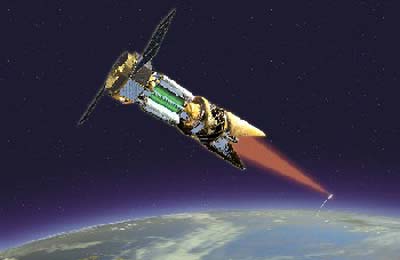More on space weaponsby Taylor Dinerman
|
| Opponents of space weapons want to lay down some red lines and insure that, whatever happens, any future administration that wants to build and deploy these weapons will have be in for a tough fight. |
This is not just a question of logic; the real issue is responsibility. Any commander, from the youngest infantry platoon leader to the commander in chief, who does not commit first and foremost to winning on the battlefield, has failed in his or her duty to both the mission and to their soldiers. Leaders who fail to give their troops the right tools for the job are properly held to account, as Donald Rumsfeld has learned in the case of the up-armored Humvees. Americans generally have little patience with those who cite procurement regulations or international public opinion as excuses for not giving our forces the right equipment.
In an age when satellite-guided weapons may be used against American forces overseas as well as against the cities of our homeland, the case for having offensive counterspace systems is a very strong one. The case for non-nuclear, space-based, boost-phase intercept weapons is equally valid.
The case for defensive systems is even stronger. Our satellites are currently almost defenseless: they could move out of the way of an enemy ASAT but only if Air Force Space Command can properly identify the threat in time. Ms. Hitchens claims “There are no anti-satellite weapons aimed at US satellites,” yet, like myself, she also has no access to classified information. There are also the many failures of the US intelligence establishment to correctly assess hostile and potentially hostile military capabilities over the recent decades. (In this regard the Iraq WMD stockpile estimates were unusual only in that they overestimated enemy weapons instead of the other way around.) We could discover that improvised space munitions could be as deadly to our satellites as improvised explosive devices are to our troops in Iraq. No responsible American leader can take it for granted that our space assets are immune from attack.
Ms. Hitchens also states that such weapons are unlikely to appear in the hands of potential adversaries for at least another decade. Given standard Defense Department development times, this is not a comfortable delay. It takes roughly that long to set the specifications and develop an early prototype of even the simplest and best understood major military system. By this fall, it will have taken the Air Force a quarter of a century to go from the initial Advanced Tactical Fighter concept to the first operational squadron of F-22s. If we are going to need an ASAT weapon in, say, 2020, they had better start work on it now.
| If we are going to need an ASAT weapon in, say, 2020, the DOD had better start work on it now. |
Where I agree with Ms. Hitchens is that we need to debate these decisions now, and to do so out in the open. Even if, as I suspect, most of the increases in the classified space budget are going to fix the same kind of problems that have caused the huge cost overruns in unclassified systems such as the SBIRS missile launch detection satellite, the leaders in the Pentagon should not expect to be able to keep an ASAT or other space weapons program secret for very long. It would be better to accept the challenge of open debate and, if necessary, make it an election issue than to think that somehow the American people do not have a “need to know”.
When it comes to the political question of whether or not the US should have more or less military strength, the American people have generally accepted that more is better. Since the attack on 9/11 this feeling is even stronger. If the choice is between strength and weakness or passing some sort of “global test”, the results of last November’s election were pretty clear. The administration should not hesitate to begin work on systems that will make America safer and stronger and in doing so it should be ready to debate those who feel otherwise.
